Assessing Microcredit's Impact on Small Businesses in India
VerifiedAdded on 2023/01/05
|54
|13860
|73
Dissertation
AI Summary
This dissertation, focusing on Oracle Financial Services Software Limited, investigates the impact of microcredit on small businesses in India. It explores the historical influence of microcredit, its recent benefits, and its effect on organizational growth. The research methodology includes an examination of research philosophy, approach, strategy, and data collection methods such as sampling and ethical considerations. The study analyzes the impact of microcredit in business and its role in empowering immigrants. It also examines the benefits of microcredit for small businesses, including easier loan approvals and fewer complications. The dissertation reviews the literature on microfinance, microcredit institutions, and the role of microcredit in business development. The findings and recommendations are presented, aiming to offer insights into the significance of microcredit in India's economic landscape. This study is a contribution to the platform Desklib, providing students with valuable insights into financial analysis and business management.
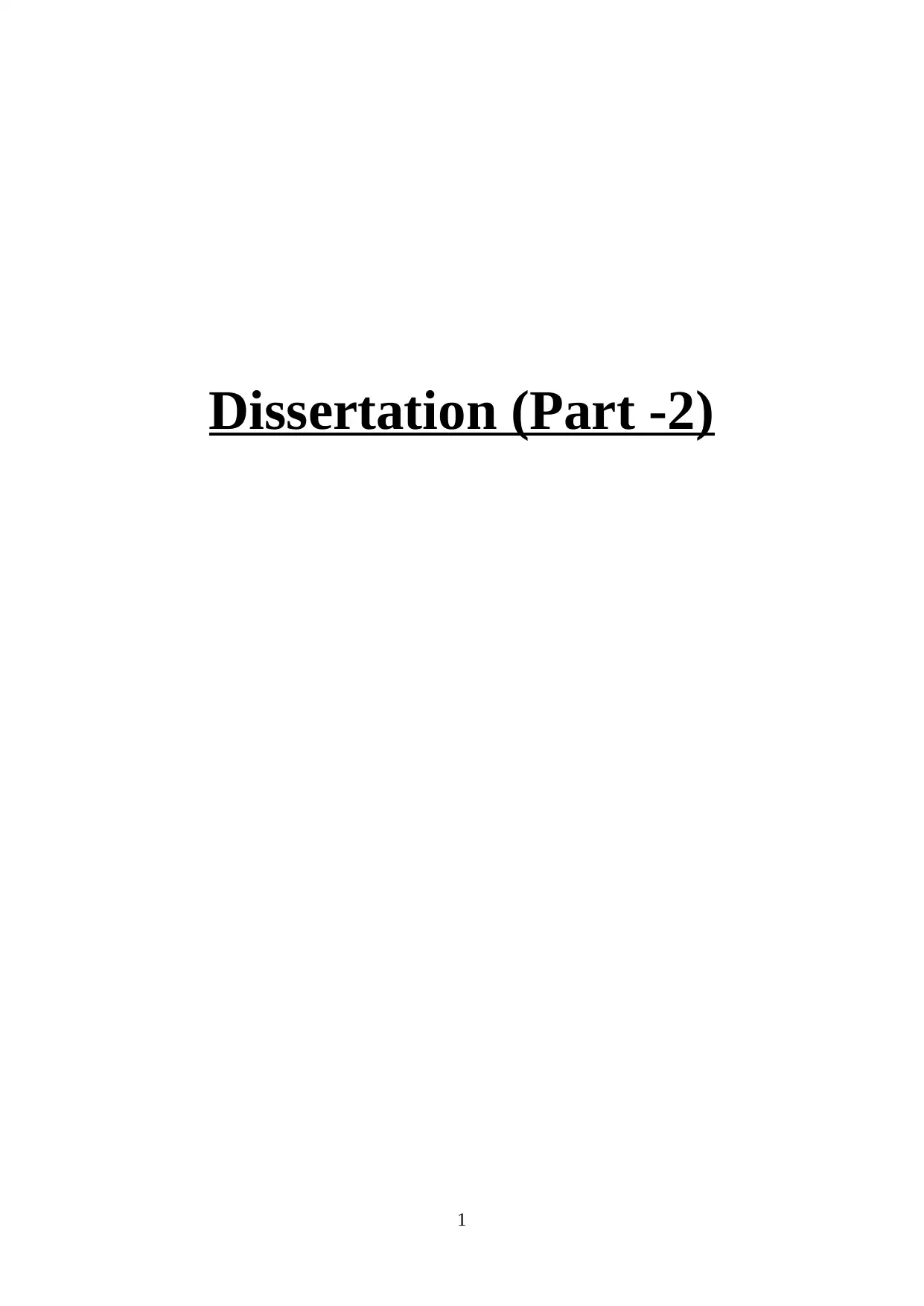
Dissertation (Part -2)
1
1
Paraphrase This Document
Need a fresh take? Get an instant paraphrase of this document with our AI Paraphraser
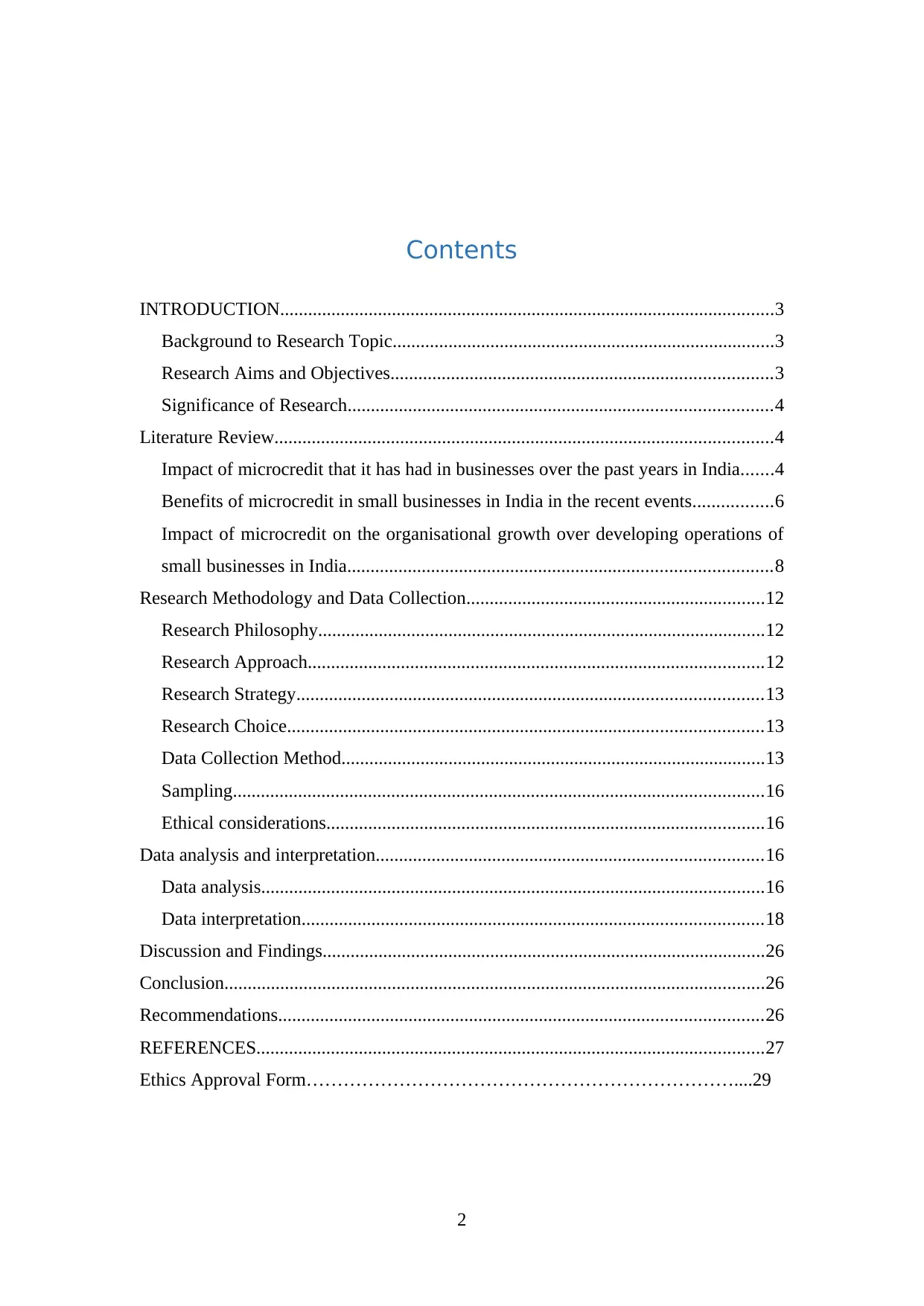
Contents
INTRODUCTION..........................................................................................................3
Background to Research Topic..................................................................................3
Research Aims and Objectives..................................................................................3
Significance of Research...........................................................................................4
Literature Review...........................................................................................................4
Impact of microcredit that it has had in businesses over the past years in India.......4
Benefits of microcredit in small businesses in India in the recent events.................6
Impact of microcredit on the organisational growth over developing operations of
small businesses in India...........................................................................................8
Research Methodology and Data Collection................................................................12
Research Philosophy................................................................................................12
Research Approach..................................................................................................12
Research Strategy....................................................................................................13
Research Choice......................................................................................................13
Data Collection Method...........................................................................................13
Sampling..................................................................................................................16
Ethical considerations..............................................................................................16
Data analysis and interpretation...................................................................................16
Data analysis............................................................................................................16
Data interpretation...................................................................................................18
Discussion and Findings...............................................................................................26
Conclusion....................................................................................................................26
Recommendations........................................................................................................26
REFERENCES.............................................................................................................27
Ethics Approval Form……………………………………………………………....29
2
INTRODUCTION..........................................................................................................3
Background to Research Topic..................................................................................3
Research Aims and Objectives..................................................................................3
Significance of Research...........................................................................................4
Literature Review...........................................................................................................4
Impact of microcredit that it has had in businesses over the past years in India.......4
Benefits of microcredit in small businesses in India in the recent events.................6
Impact of microcredit on the organisational growth over developing operations of
small businesses in India...........................................................................................8
Research Methodology and Data Collection................................................................12
Research Philosophy................................................................................................12
Research Approach..................................................................................................12
Research Strategy....................................................................................................13
Research Choice......................................................................................................13
Data Collection Method...........................................................................................13
Sampling..................................................................................................................16
Ethical considerations..............................................................................................16
Data analysis and interpretation...................................................................................16
Data analysis............................................................................................................16
Data interpretation...................................................................................................18
Discussion and Findings...............................................................................................26
Conclusion....................................................................................................................26
Recommendations........................................................................................................26
REFERENCES.............................................................................................................27
Ethics Approval Form……………………………………………………………....29
2
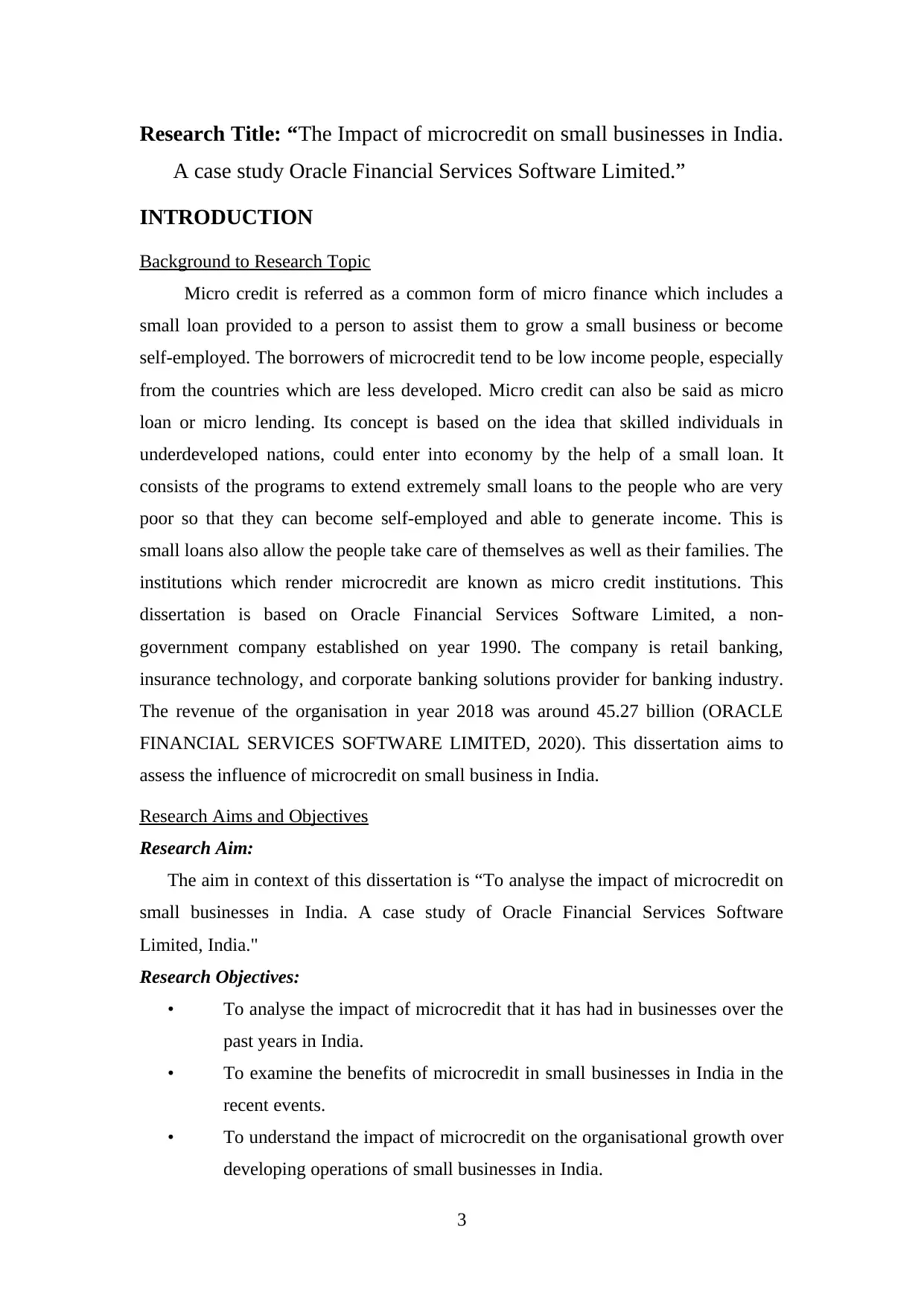
Research Title: “The Impact of microcredit on small businesses in India.
A case study Oracle Financial Services Software Limited.”
INTRODUCTION
Background to Research Topic
Micro credit is referred as a common form of micro finance which includes a
small loan provided to a person to assist them to grow a small business or become
self-employed. The borrowers of microcredit tend to be low income people, especially
from the countries which are less developed. Micro credit can also be said as micro
loan or micro lending. Its concept is based on the idea that skilled individuals in
underdeveloped nations, could enter into economy by the help of a small loan. It
consists of the programs to extend extremely small loans to the people who are very
poor so that they can become self-employed and able to generate income. This is
small loans also allow the people take care of themselves as well as their families. The
institutions which render microcredit are known as micro credit institutions. This
dissertation is based on Oracle Financial Services Software Limited, a non-
government company established on year 1990. The company is retail banking,
insurance technology, and corporate banking solutions provider for banking industry.
The revenue of the organisation in year 2018 was around 45.27 billion (ORACLE
FINANCIAL SERVICES SOFTWARE LIMITED, 2020). This dissertation aims to
assess the influence of microcredit on small business in India.
Research Aims and Objectives
Research Aim:
The aim in context of this dissertation is “To analyse the impact of microcredit on
small businesses in India. A case study of Oracle Financial Services Software
Limited, India."
Research Objectives:
• To analyse the impact of microcredit that it has had in businesses over the
past years in India.
• To examine the benefits of microcredit in small businesses in India in the
recent events.
• To understand the impact of microcredit on the organisational growth over
developing operations of small businesses in India.
3
A case study Oracle Financial Services Software Limited.”
INTRODUCTION
Background to Research Topic
Micro credit is referred as a common form of micro finance which includes a
small loan provided to a person to assist them to grow a small business or become
self-employed. The borrowers of microcredit tend to be low income people, especially
from the countries which are less developed. Micro credit can also be said as micro
loan or micro lending. Its concept is based on the idea that skilled individuals in
underdeveloped nations, could enter into economy by the help of a small loan. It
consists of the programs to extend extremely small loans to the people who are very
poor so that they can become self-employed and able to generate income. This is
small loans also allow the people take care of themselves as well as their families. The
institutions which render microcredit are known as micro credit institutions. This
dissertation is based on Oracle Financial Services Software Limited, a non-
government company established on year 1990. The company is retail banking,
insurance technology, and corporate banking solutions provider for banking industry.
The revenue of the organisation in year 2018 was around 45.27 billion (ORACLE
FINANCIAL SERVICES SOFTWARE LIMITED, 2020). This dissertation aims to
assess the influence of microcredit on small business in India.
Research Aims and Objectives
Research Aim:
The aim in context of this dissertation is “To analyse the impact of microcredit on
small businesses in India. A case study of Oracle Financial Services Software
Limited, India."
Research Objectives:
• To analyse the impact of microcredit that it has had in businesses over the
past years in India.
• To examine the benefits of microcredit in small businesses in India in the
recent events.
• To understand the impact of microcredit on the organisational growth over
developing operations of small businesses in India.
3
⊘ This is a preview!⊘
Do you want full access?
Subscribe today to unlock all pages.

Trusted by 1+ million students worldwide
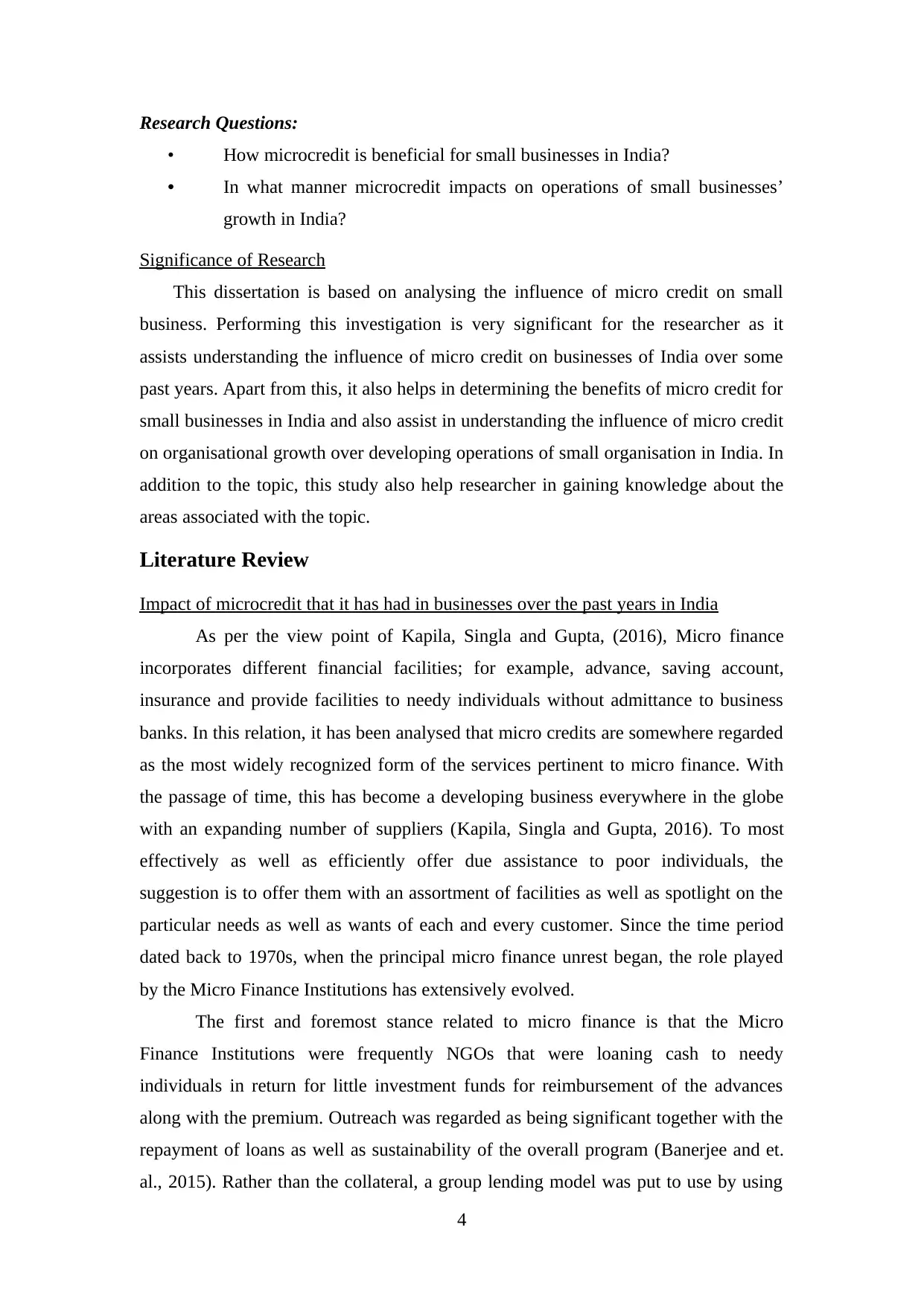
Research Questions:
• How microcredit is beneficial for small businesses in India?
• In what manner microcredit impacts on operations of small businesses’
growth in India?
Significance of Research
This dissertation is based on analysing the influence of micro credit on small
business. Performing this investigation is very significant for the researcher as it
assists understanding the influence of micro credit on businesses of India over some
past years. Apart from this, it also helps in determining the benefits of micro credit for
small businesses in India and also assist in understanding the influence of micro credit
on organisational growth over developing operations of small organisation in India. In
addition to the topic, this study also help researcher in gaining knowledge about the
areas associated with the topic.
Literature Review
Impact of microcredit that it has had in businesses over the past years in India
As per the view point of Kapila, Singla and Gupta, (2016), Micro finance
incorporates different financial facilities; for example, advance, saving account,
insurance and provide facilities to needy individuals without admittance to business
banks. In this relation, it has been analysed that micro credits are somewhere regarded
as the most widely recognized form of the services pertinent to micro finance. With
the passage of time, this has become a developing business everywhere in the globe
with an expanding number of suppliers (Kapila, Singla and Gupta, 2016). To most
effectively as well as efficiently offer due assistance to poor individuals, the
suggestion is to offer them with an assortment of facilities as well as spotlight on the
particular needs as well as wants of each and every customer. Since the time period
dated back to 1970s, when the principal micro finance unrest began, the role played
by the Micro Finance Institutions has extensively evolved.
The first and foremost stance related to micro finance is that the Micro
Finance Institutions were frequently NGOs that were loaning cash to needy
individuals in return for little investment funds for reimbursement of the advances
along with the premium. Outreach was regarded as being significant together with the
repayment of loans as well as sustainability of the overall program (Banerjee and et.
al., 2015). Rather than the collateral, a group lending model was put to use by using
4
• How microcredit is beneficial for small businesses in India?
• In what manner microcredit impacts on operations of small businesses’
growth in India?
Significance of Research
This dissertation is based on analysing the influence of micro credit on small
business. Performing this investigation is very significant for the researcher as it
assists understanding the influence of micro credit on businesses of India over some
past years. Apart from this, it also helps in determining the benefits of micro credit for
small businesses in India and also assist in understanding the influence of micro credit
on organisational growth over developing operations of small organisation in India. In
addition to the topic, this study also help researcher in gaining knowledge about the
areas associated with the topic.
Literature Review
Impact of microcredit that it has had in businesses over the past years in India
As per the view point of Kapila, Singla and Gupta, (2016), Micro finance
incorporates different financial facilities; for example, advance, saving account,
insurance and provide facilities to needy individuals without admittance to business
banks. In this relation, it has been analysed that micro credits are somewhere regarded
as the most widely recognized form of the services pertinent to micro finance. With
the passage of time, this has become a developing business everywhere in the globe
with an expanding number of suppliers (Kapila, Singla and Gupta, 2016). To most
effectively as well as efficiently offer due assistance to poor individuals, the
suggestion is to offer them with an assortment of facilities as well as spotlight on the
particular needs as well as wants of each and every customer. Since the time period
dated back to 1970s, when the principal micro finance unrest began, the role played
by the Micro Finance Institutions has extensively evolved.
The first and foremost stance related to micro finance is that the Micro
Finance Institutions were frequently NGOs that were loaning cash to needy
individuals in return for little investment funds for reimbursement of the advances
along with the premium. Outreach was regarded as being significant together with the
repayment of loans as well as sustainability of the overall program (Banerjee and et.
al., 2015). Rather than the collateral, a group lending model was put to use by using
4
Paraphrase This Document
Need a fresh take? Get an instant paraphrase of this document with our AI Paraphraser
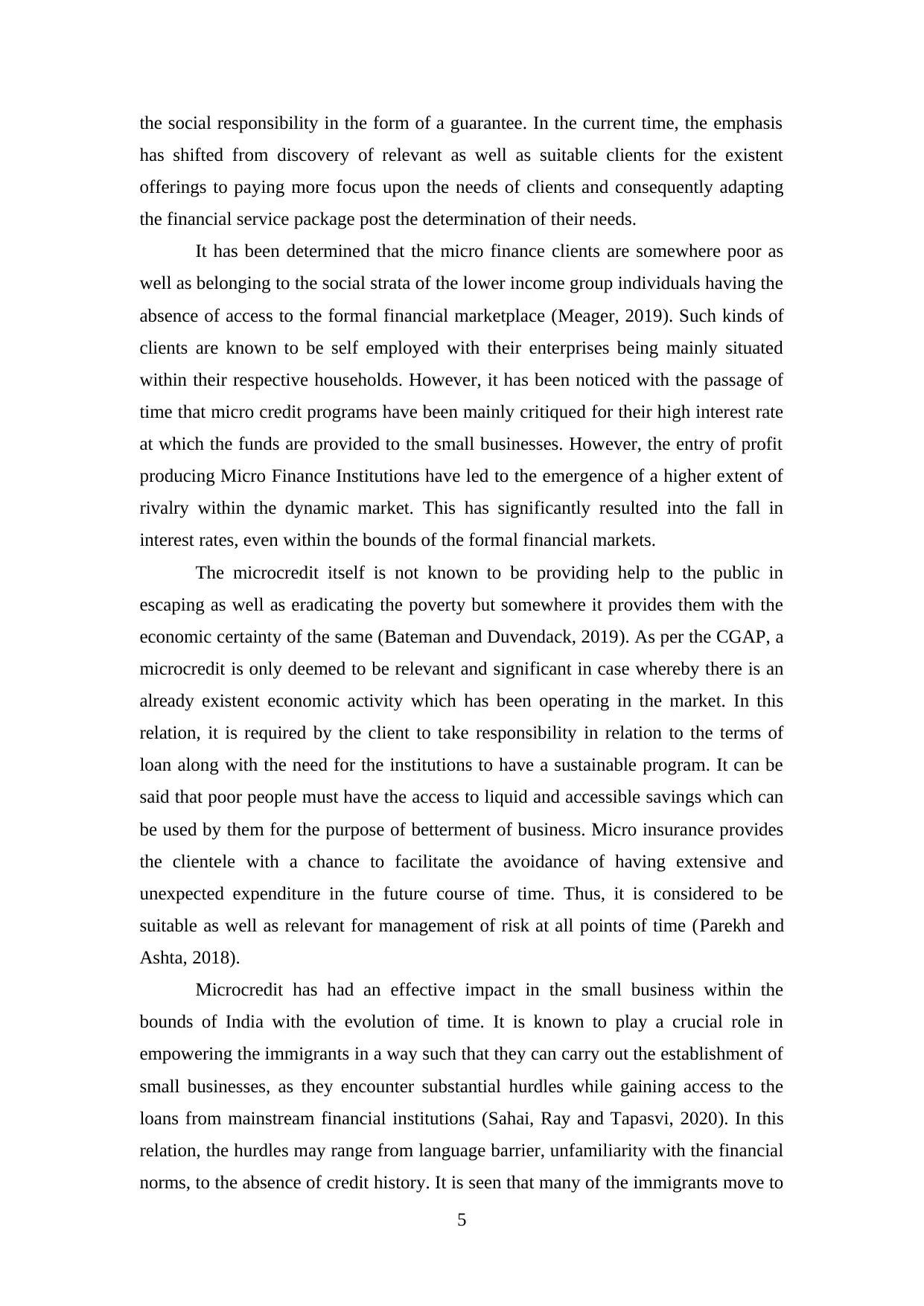
the social responsibility in the form of a guarantee. In the current time, the emphasis
has shifted from discovery of relevant as well as suitable clients for the existent
offerings to paying more focus upon the needs of clients and consequently adapting
the financial service package post the determination of their needs.
It has been determined that the micro finance clients are somewhere poor as
well as belonging to the social strata of the lower income group individuals having the
absence of access to the formal financial marketplace (Meager, 2019). Such kinds of
clients are known to be self employed with their enterprises being mainly situated
within their respective households. However, it has been noticed with the passage of
time that micro credit programs have been mainly critiqued for their high interest rate
at which the funds are provided to the small businesses. However, the entry of profit
producing Micro Finance Institutions have led to the emergence of a higher extent of
rivalry within the dynamic market. This has significantly resulted into the fall in
interest rates, even within the bounds of the formal financial markets.
The microcredit itself is not known to be providing help to the public in
escaping as well as eradicating the poverty but somewhere it provides them with the
economic certainty of the same (Bateman and Duvendack, 2019). As per the CGAP, a
microcredit is only deemed to be relevant and significant in case whereby there is an
already existent economic activity which has been operating in the market. In this
relation, it is required by the client to take responsibility in relation to the terms of
loan along with the need for the institutions to have a sustainable program. It can be
said that poor people must have the access to liquid and accessible savings which can
be used by them for the purpose of betterment of business. Micro insurance provides
the clientele with a chance to facilitate the avoidance of having extensive and
unexpected expenditure in the future course of time. Thus, it is considered to be
suitable as well as relevant for management of risk at all points of time (Parekh and
Ashta, 2018).
Microcredit has had an effective impact in the small business within the
bounds of India with the evolution of time. It is known to play a crucial role in
empowering the immigrants in a way such that they can carry out the establishment of
small businesses, as they encounter substantial hurdles while gaining access to the
loans from mainstream financial institutions (Sahai, Ray and Tapasvi, 2020). In this
relation, the hurdles may range from language barrier, unfamiliarity with the financial
norms, to the absence of credit history. It is seen that many of the immigrants move to
5
has shifted from discovery of relevant as well as suitable clients for the existent
offerings to paying more focus upon the needs of clients and consequently adapting
the financial service package post the determination of their needs.
It has been determined that the micro finance clients are somewhere poor as
well as belonging to the social strata of the lower income group individuals having the
absence of access to the formal financial marketplace (Meager, 2019). Such kinds of
clients are known to be self employed with their enterprises being mainly situated
within their respective households. However, it has been noticed with the passage of
time that micro credit programs have been mainly critiqued for their high interest rate
at which the funds are provided to the small businesses. However, the entry of profit
producing Micro Finance Institutions have led to the emergence of a higher extent of
rivalry within the dynamic market. This has significantly resulted into the fall in
interest rates, even within the bounds of the formal financial markets.
The microcredit itself is not known to be providing help to the public in
escaping as well as eradicating the poverty but somewhere it provides them with the
economic certainty of the same (Bateman and Duvendack, 2019). As per the CGAP, a
microcredit is only deemed to be relevant and significant in case whereby there is an
already existent economic activity which has been operating in the market. In this
relation, it is required by the client to take responsibility in relation to the terms of
loan along with the need for the institutions to have a sustainable program. It can be
said that poor people must have the access to liquid and accessible savings which can
be used by them for the purpose of betterment of business. Micro insurance provides
the clientele with a chance to facilitate the avoidance of having extensive and
unexpected expenditure in the future course of time. Thus, it is considered to be
suitable as well as relevant for management of risk at all points of time (Parekh and
Ashta, 2018).
Microcredit has had an effective impact in the small business within the
bounds of India with the evolution of time. It is known to play a crucial role in
empowering the immigrants in a way such that they can carry out the establishment of
small businesses, as they encounter substantial hurdles while gaining access to the
loans from mainstream financial institutions (Sahai, Ray and Tapasvi, 2020). In this
relation, the hurdles may range from language barrier, unfamiliarity with the financial
norms, to the absence of credit history. It is seen that many of the immigrants move to
5
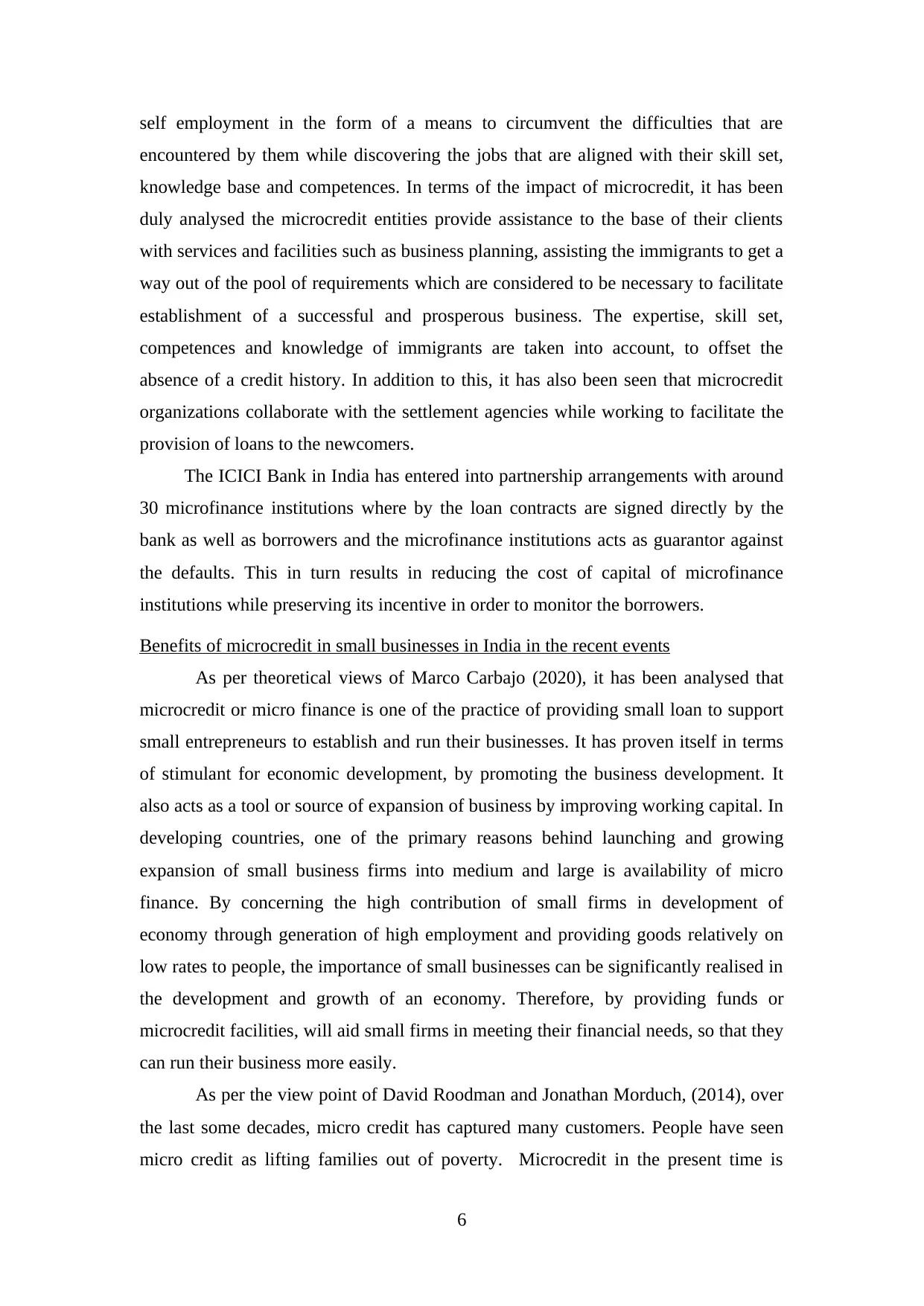
self employment in the form of a means to circumvent the difficulties that are
encountered by them while discovering the jobs that are aligned with their skill set,
knowledge base and competences. In terms of the impact of microcredit, it has been
duly analysed the microcredit entities provide assistance to the base of their clients
with services and facilities such as business planning, assisting the immigrants to get a
way out of the pool of requirements which are considered to be necessary to facilitate
establishment of a successful and prosperous business. The expertise, skill set,
competences and knowledge of immigrants are taken into account, to offset the
absence of a credit history. In addition to this, it has also been seen that microcredit
organizations collaborate with the settlement agencies while working to facilitate the
provision of loans to the newcomers.
The ICICI Bank in India has entered into partnership arrangements with around
30 microfinance institutions where by the loan contracts are signed directly by the
bank as well as borrowers and the microfinance institutions acts as guarantor against
the defaults. This in turn results in reducing the cost of capital of microfinance
institutions while preserving its incentive in order to monitor the borrowers.
Benefits of microcredit in small businesses in India in the recent events
As per theoretical views of Marco Carbajo (2020), it has been analysed that
microcredit or micro finance is one of the practice of providing small loan to support
small entrepreneurs to establish and run their businesses. It has proven itself in terms
of stimulant for economic development, by promoting the business development. It
also acts as a tool or source of expansion of business by improving working capital. In
developing countries, one of the primary reasons behind launching and growing
expansion of small business firms into medium and large is availability of micro
finance. By concerning the high contribution of small firms in development of
economy through generation of high employment and providing goods relatively on
low rates to people, the importance of small businesses can be significantly realised in
the development and growth of an economy. Therefore, by providing funds or
microcredit facilities, will aid small firms in meeting their financial needs, so that they
can run their business more easily.
As per the view point of David Roodman and Jonathan Morduch, (2014), over
the last some decades, micro credit has captured many customers. People have seen
micro credit as lifting families out of poverty. Microcredit in the present time is
6
encountered by them while discovering the jobs that are aligned with their skill set,
knowledge base and competences. In terms of the impact of microcredit, it has been
duly analysed the microcredit entities provide assistance to the base of their clients
with services and facilities such as business planning, assisting the immigrants to get a
way out of the pool of requirements which are considered to be necessary to facilitate
establishment of a successful and prosperous business. The expertise, skill set,
competences and knowledge of immigrants are taken into account, to offset the
absence of a credit history. In addition to this, it has also been seen that microcredit
organizations collaborate with the settlement agencies while working to facilitate the
provision of loans to the newcomers.
The ICICI Bank in India has entered into partnership arrangements with around
30 microfinance institutions where by the loan contracts are signed directly by the
bank as well as borrowers and the microfinance institutions acts as guarantor against
the defaults. This in turn results in reducing the cost of capital of microfinance
institutions while preserving its incentive in order to monitor the borrowers.
Benefits of microcredit in small businesses in India in the recent events
As per theoretical views of Marco Carbajo (2020), it has been analysed that
microcredit or micro finance is one of the practice of providing small loan to support
small entrepreneurs to establish and run their businesses. It has proven itself in terms
of stimulant for economic development, by promoting the business development. It
also acts as a tool or source of expansion of business by improving working capital. In
developing countries, one of the primary reasons behind launching and growing
expansion of small business firms into medium and large is availability of micro
finance. By concerning the high contribution of small firms in development of
economy through generation of high employment and providing goods relatively on
low rates to people, the importance of small businesses can be significantly realised in
the development and growth of an economy. Therefore, by providing funds or
microcredit facilities, will aid small firms in meeting their financial needs, so that they
can run their business more easily.
As per the view point of David Roodman and Jonathan Morduch, (2014), over
the last some decades, micro credit has captured many customers. People have seen
micro credit as lifting families out of poverty. Microcredit in the present time is
6
⊘ This is a preview!⊘
Do you want full access?
Subscribe today to unlock all pages.

Trusted by 1+ million students worldwide
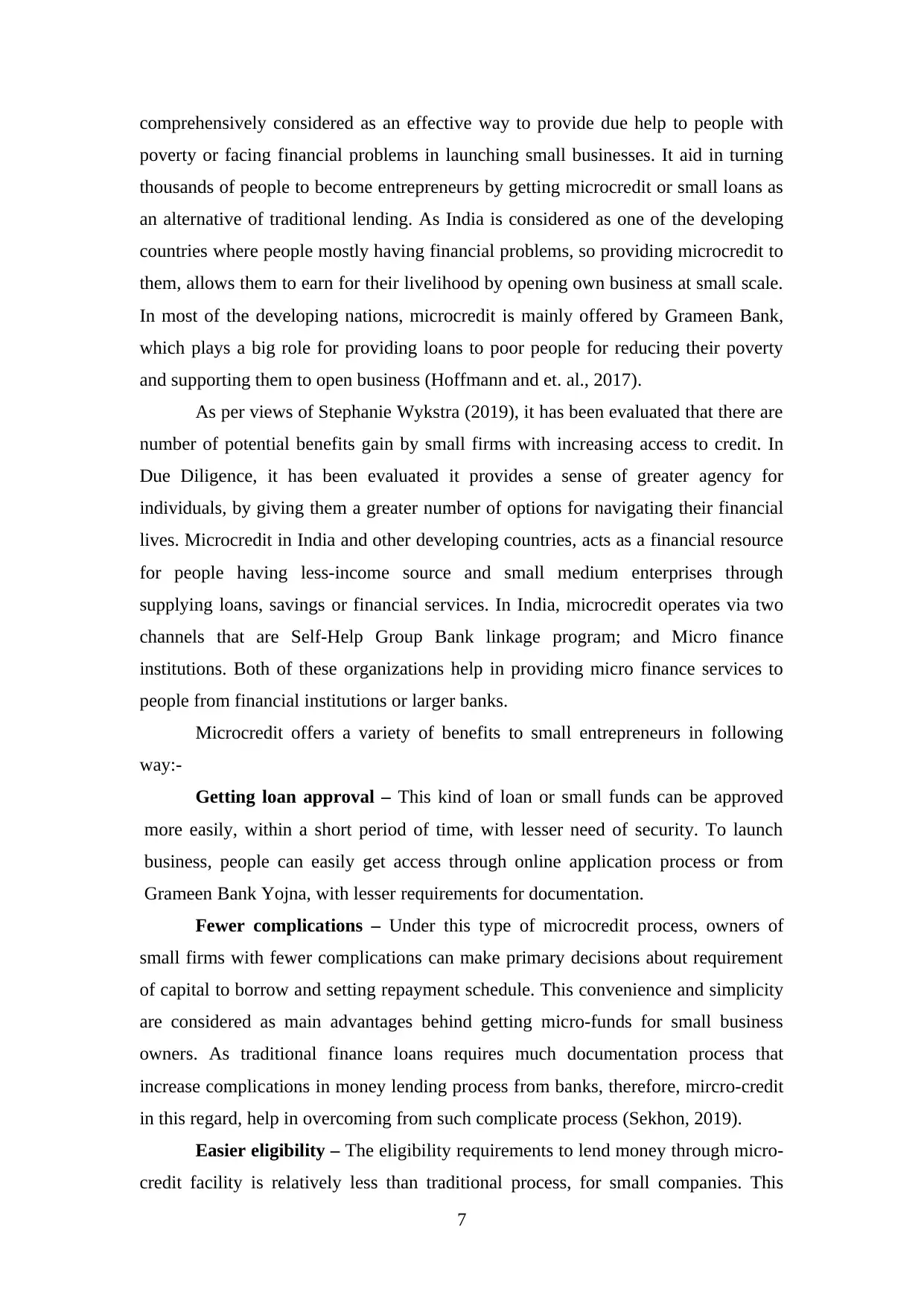
comprehensively considered as an effective way to provide due help to people with
poverty or facing financial problems in launching small businesses. It aid in turning
thousands of people to become entrepreneurs by getting microcredit or small loans as
an alternative of traditional lending. As India is considered as one of the developing
countries where people mostly having financial problems, so providing microcredit to
them, allows them to earn for their livelihood by opening own business at small scale.
In most of the developing nations, microcredit is mainly offered by Grameen Bank,
which plays a big role for providing loans to poor people for reducing their poverty
and supporting them to open business (Hoffmann and et. al., 2017).
As per views of Stephanie Wykstra (2019), it has been evaluated that there are
number of potential benefits gain by small firms with increasing access to credit. In
Due Diligence, it has been evaluated it provides a sense of greater agency for
individuals, by giving them a greater number of options for navigating their financial
lives. Microcredit in India and other developing countries, acts as a financial resource
for people having less-income source and small medium enterprises through
supplying loans, savings or financial services. In India, microcredit operates via two
channels that are Self-Help Group Bank linkage program; and Micro finance
institutions. Both of these organizations help in providing micro finance services to
people from financial institutions or larger banks.
Microcredit offers a variety of benefits to small entrepreneurs in following
way:-
Getting loan approval – This kind of loan or small funds can be approved
more easily, within a short period of time, with lesser need of security. To launch
business, people can easily get access through online application process or from
Grameen Bank Yojna, with lesser requirements for documentation.
Fewer complications – Under this type of microcredit process, owners of
small firms with fewer complications can make primary decisions about requirement
of capital to borrow and setting repayment schedule. This convenience and simplicity
are considered as main advantages behind getting micro-funds for small business
owners. As traditional finance loans requires much documentation process that
increase complications in money lending process from banks, therefore, mircro-credit
in this regard, help in overcoming from such complicate process (Sekhon, 2019).
Easier eligibility – The eligibility requirements to lend money through micro-
credit facility is relatively less than traditional process, for small companies. This
7
poverty or facing financial problems in launching small businesses. It aid in turning
thousands of people to become entrepreneurs by getting microcredit or small loans as
an alternative of traditional lending. As India is considered as one of the developing
countries where people mostly having financial problems, so providing microcredit to
them, allows them to earn for their livelihood by opening own business at small scale.
In most of the developing nations, microcredit is mainly offered by Grameen Bank,
which plays a big role for providing loans to poor people for reducing their poverty
and supporting them to open business (Hoffmann and et. al., 2017).
As per views of Stephanie Wykstra (2019), it has been evaluated that there are
number of potential benefits gain by small firms with increasing access to credit. In
Due Diligence, it has been evaluated it provides a sense of greater agency for
individuals, by giving them a greater number of options for navigating their financial
lives. Microcredit in India and other developing countries, acts as a financial resource
for people having less-income source and small medium enterprises through
supplying loans, savings or financial services. In India, microcredit operates via two
channels that are Self-Help Group Bank linkage program; and Micro finance
institutions. Both of these organizations help in providing micro finance services to
people from financial institutions or larger banks.
Microcredit offers a variety of benefits to small entrepreneurs in following
way:-
Getting loan approval – This kind of loan or small funds can be approved
more easily, within a short period of time, with lesser need of security. To launch
business, people can easily get access through online application process or from
Grameen Bank Yojna, with lesser requirements for documentation.
Fewer complications – Under this type of microcredit process, owners of
small firms with fewer complications can make primary decisions about requirement
of capital to borrow and setting repayment schedule. This convenience and simplicity
are considered as main advantages behind getting micro-funds for small business
owners. As traditional finance loans requires much documentation process that
increase complications in money lending process from banks, therefore, mircro-credit
in this regard, help in overcoming from such complicate process (Sekhon, 2019).
Easier eligibility – The eligibility requirements to lend money through micro-
credit facility is relatively less than traditional process, for small companies. This
7
Paraphrase This Document
Need a fresh take? Get an instant paraphrase of this document with our AI Paraphraser
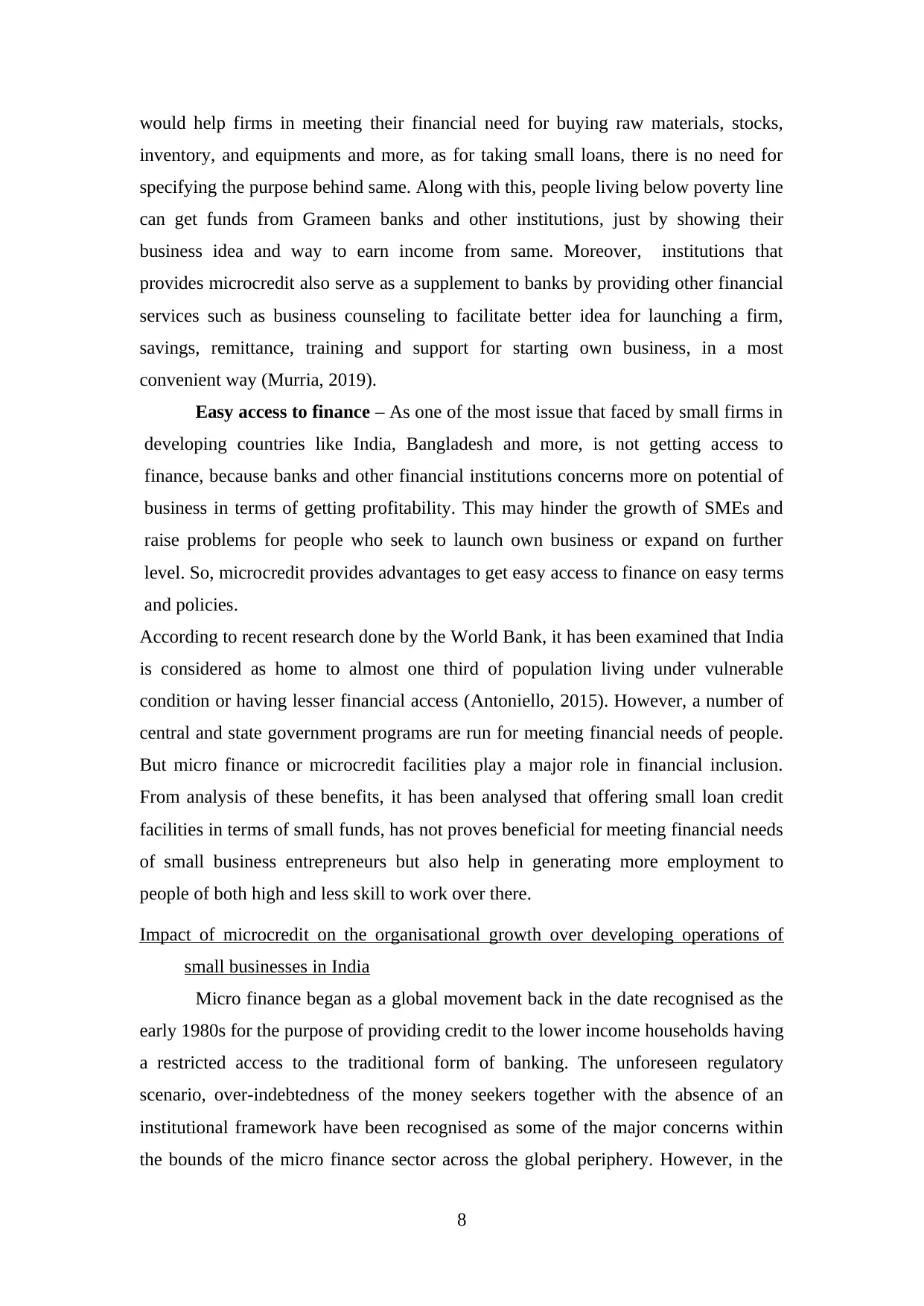
would help firms in meeting their financial need for buying raw materials, stocks,
inventory, and equipments and more, as for taking small loans, there is no need for
specifying the purpose behind same. Along with this, people living below poverty line
can get funds from Grameen banks and other institutions, just by showing their
business idea and way to earn income from same. Moreover, institutions that
provides microcredit also serve as a supplement to banks by providing other financial
services such as business counseling to facilitate better idea for launching a firm,
savings, remittance, training and support for starting own business, in a most
convenient way (Murria, 2019).
Easy access to finance – As one of the most issue that faced by small firms in
developing countries like India, Bangladesh and more, is not getting access to
finance, because banks and other financial institutions concerns more on potential of
business in terms of getting profitability. This may hinder the growth of SMEs and
raise problems for people who seek to launch own business or expand on further
level. So, microcredit provides advantages to get easy access to finance on easy terms
and policies.
According to recent research done by the World Bank, it has been examined that India
is considered as home to almost one third of population living under vulnerable
condition or having lesser financial access (Antoniello, 2015). However, a number of
central and state government programs are run for meeting financial needs of people.
But micro finance or microcredit facilities play a major role in financial inclusion.
From analysis of these benefits, it has been analysed that offering small loan credit
facilities in terms of small funds, has not proves beneficial for meeting financial needs
of small business entrepreneurs but also help in generating more employment to
people of both high and less skill to work over there.
Impact of microcredit on the organisational growth over developing operations of
small businesses in India
Micro finance began as a global movement back in the date recognised as the
early 1980s for the purpose of providing credit to the lower income households having
a restricted access to the traditional form of banking. The unforeseen regulatory
scenario, over-indebtedness of the money seekers together with the absence of an
institutional framework have been recognised as some of the major concerns within
the bounds of the micro finance sector across the global periphery. However, in the
8
inventory, and equipments and more, as for taking small loans, there is no need for
specifying the purpose behind same. Along with this, people living below poverty line
can get funds from Grameen banks and other institutions, just by showing their
business idea and way to earn income from same. Moreover, institutions that
provides microcredit also serve as a supplement to banks by providing other financial
services such as business counseling to facilitate better idea for launching a firm,
savings, remittance, training and support for starting own business, in a most
convenient way (Murria, 2019).
Easy access to finance – As one of the most issue that faced by small firms in
developing countries like India, Bangladesh and more, is not getting access to
finance, because banks and other financial institutions concerns more on potential of
business in terms of getting profitability. This may hinder the growth of SMEs and
raise problems for people who seek to launch own business or expand on further
level. So, microcredit provides advantages to get easy access to finance on easy terms
and policies.
According to recent research done by the World Bank, it has been examined that India
is considered as home to almost one third of population living under vulnerable
condition or having lesser financial access (Antoniello, 2015). However, a number of
central and state government programs are run for meeting financial needs of people.
But micro finance or microcredit facilities play a major role in financial inclusion.
From analysis of these benefits, it has been analysed that offering small loan credit
facilities in terms of small funds, has not proves beneficial for meeting financial needs
of small business entrepreneurs but also help in generating more employment to
people of both high and less skill to work over there.
Impact of microcredit on the organisational growth over developing operations of
small businesses in India
Micro finance began as a global movement back in the date recognised as the
early 1980s for the purpose of providing credit to the lower income households having
a restricted access to the traditional form of banking. The unforeseen regulatory
scenario, over-indebtedness of the money seekers together with the absence of an
institutional framework have been recognised as some of the major concerns within
the bounds of the micro finance sector across the global periphery. However, in the
8
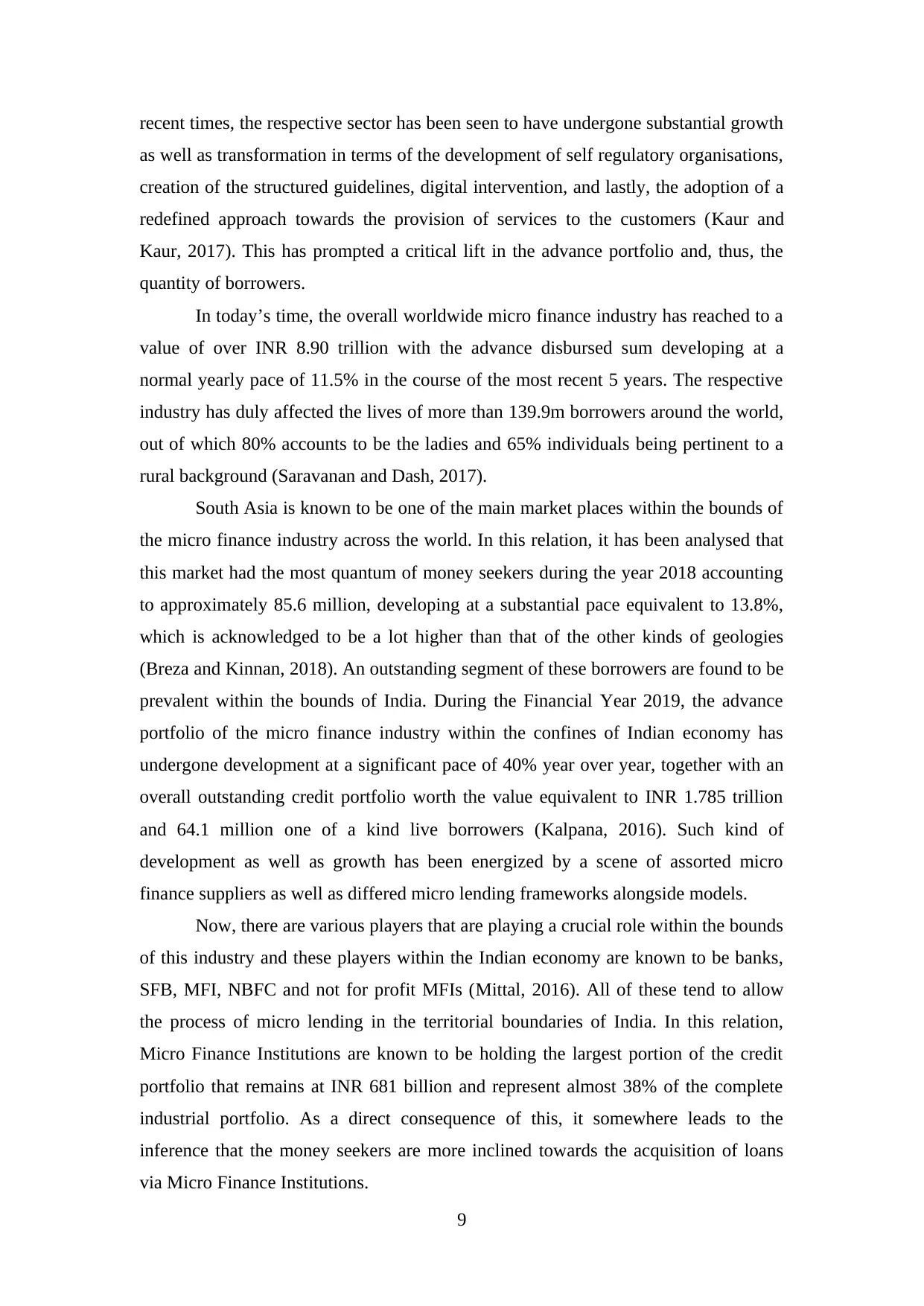
recent times, the respective sector has been seen to have undergone substantial growth
as well as transformation in terms of the development of self regulatory organisations,
creation of the structured guidelines, digital intervention, and lastly, the adoption of a
redefined approach towards the provision of services to the customers (Kaur and
Kaur, 2017). This has prompted a critical lift in the advance portfolio and, thus, the
quantity of borrowers.
In today’s time, the overall worldwide micro finance industry has reached to a
value of over INR 8.90 trillion with the advance disbursed sum developing at a
normal yearly pace of 11.5% in the course of the most recent 5 years. The respective
industry has duly affected the lives of more than 139.9m borrowers around the world,
out of which 80% accounts to be the ladies and 65% individuals being pertinent to a
rural background (Saravanan and Dash, 2017).
South Asia is known to be one of the main market places within the bounds of
the micro finance industry across the world. In this relation, it has been analysed that
this market had the most quantum of money seekers during the year 2018 accounting
to approximately 85.6 million, developing at a substantial pace equivalent to 13.8%,
which is acknowledged to be a lot higher than that of the other kinds of geologies
(Breza and Kinnan, 2018). An outstanding segment of these borrowers are found to be
prevalent within the bounds of India. During the Financial Year 2019, the advance
portfolio of the micro finance industry within the confines of Indian economy has
undergone development at a significant pace of 40% year over year, together with an
overall outstanding credit portfolio worth the value equivalent to INR 1.785 trillion
and 64.1 million one of a kind live borrowers (Kalpana, 2016). Such kind of
development as well as growth has been energized by a scene of assorted micro
finance suppliers as well as differed micro lending frameworks alongside models.
Now, there are various players that are playing a crucial role within the bounds
of this industry and these players within the Indian economy are known to be banks,
SFB, MFI, NBFC and not for profit MFIs (Mittal, 2016). All of these tend to allow
the process of micro lending in the territorial boundaries of India. In this relation,
Micro Finance Institutions are known to be holding the largest portion of the credit
portfolio that remains at INR 681 billion and represent almost 38% of the complete
industrial portfolio. As a direct consequence of this, it somewhere leads to the
inference that the money seekers are more inclined towards the acquisition of loans
via Micro Finance Institutions.
9
as well as transformation in terms of the development of self regulatory organisations,
creation of the structured guidelines, digital intervention, and lastly, the adoption of a
redefined approach towards the provision of services to the customers (Kaur and
Kaur, 2017). This has prompted a critical lift in the advance portfolio and, thus, the
quantity of borrowers.
In today’s time, the overall worldwide micro finance industry has reached to a
value of over INR 8.90 trillion with the advance disbursed sum developing at a
normal yearly pace of 11.5% in the course of the most recent 5 years. The respective
industry has duly affected the lives of more than 139.9m borrowers around the world,
out of which 80% accounts to be the ladies and 65% individuals being pertinent to a
rural background (Saravanan and Dash, 2017).
South Asia is known to be one of the main market places within the bounds of
the micro finance industry across the world. In this relation, it has been analysed that
this market had the most quantum of money seekers during the year 2018 accounting
to approximately 85.6 million, developing at a substantial pace equivalent to 13.8%,
which is acknowledged to be a lot higher than that of the other kinds of geologies
(Breza and Kinnan, 2018). An outstanding segment of these borrowers are found to be
prevalent within the bounds of India. During the Financial Year 2019, the advance
portfolio of the micro finance industry within the confines of Indian economy has
undergone development at a significant pace of 40% year over year, together with an
overall outstanding credit portfolio worth the value equivalent to INR 1.785 trillion
and 64.1 million one of a kind live borrowers (Kalpana, 2016). Such kind of
development as well as growth has been energized by a scene of assorted micro
finance suppliers as well as differed micro lending frameworks alongside models.
Now, there are various players that are playing a crucial role within the bounds
of this industry and these players within the Indian economy are known to be banks,
SFB, MFI, NBFC and not for profit MFIs (Mittal, 2016). All of these tend to allow
the process of micro lending in the territorial boundaries of India. In this relation,
Micro Finance Institutions are known to be holding the largest portion of the credit
portfolio that remains at INR 681 billion and represent almost 38% of the complete
industrial portfolio. As a direct consequence of this, it somewhere leads to the
inference that the money seekers are more inclined towards the acquisition of loans
via Micro Finance Institutions.
9
⊘ This is a preview!⊘
Do you want full access?
Subscribe today to unlock all pages.

Trusted by 1+ million students worldwide
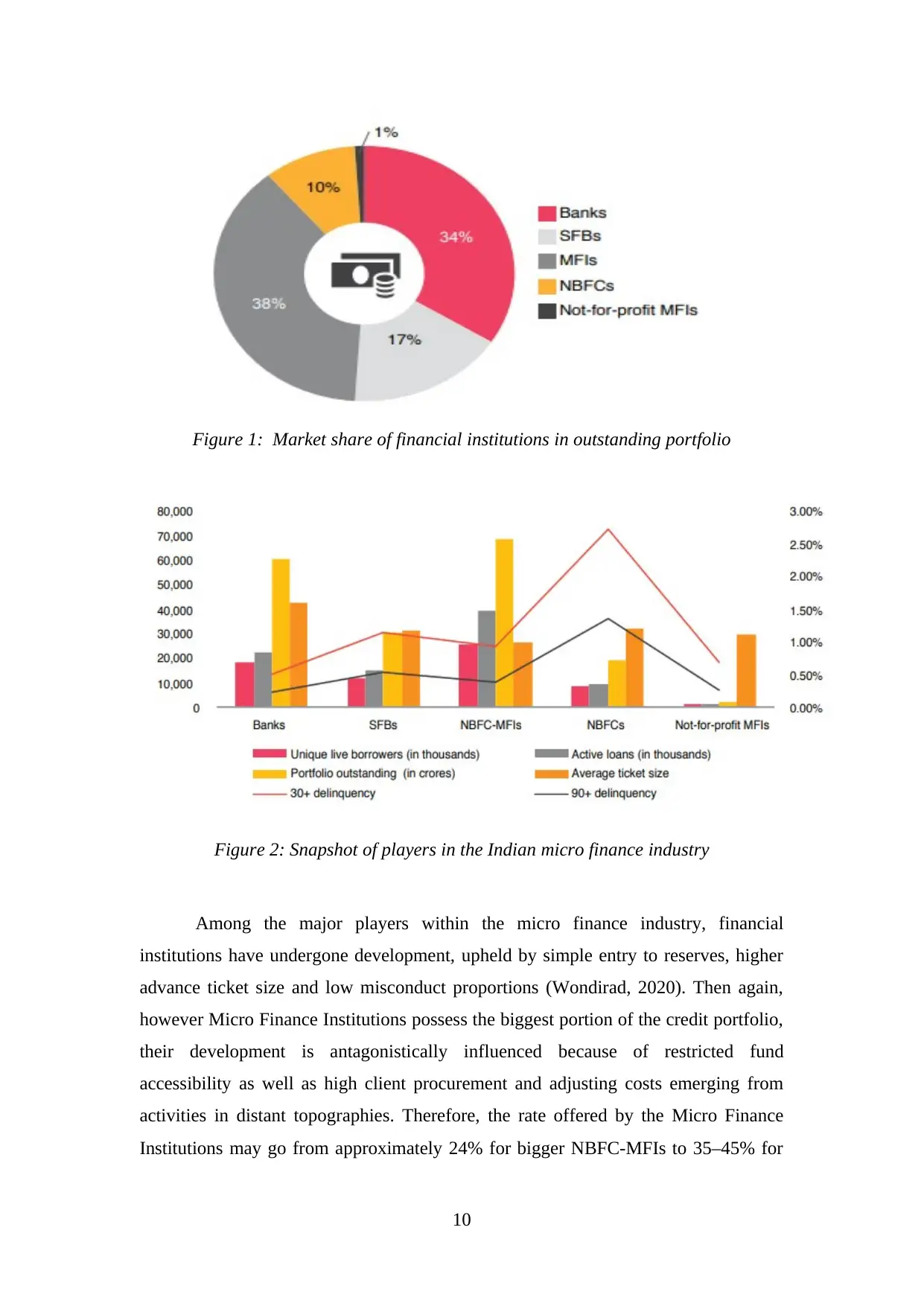
Figure 1: Market share of financial institutions in outstanding portfolio
Figure 2: Snapshot of players in the Indian micro finance industry
Among the major players within the micro finance industry, financial
institutions have undergone development, upheld by simple entry to reserves, higher
advance ticket size and low misconduct proportions (Wondirad, 2020). Then again,
however Micro Finance Institutions possess the biggest portion of the credit portfolio,
their development is antagonistically influenced because of restricted fund
accessibility as well as high client procurement and adjusting costs emerging from
activities in distant topographies. Therefore, the rate offered by the Micro Finance
Institutions may go from approximately 24% for bigger NBFC-MFIs to 35–45% for
10
Figure 2: Snapshot of players in the Indian micro finance industry
Among the major players within the micro finance industry, financial
institutions have undergone development, upheld by simple entry to reserves, higher
advance ticket size and low misconduct proportions (Wondirad, 2020). Then again,
however Micro Finance Institutions possess the biggest portion of the credit portfolio,
their development is antagonistically influenced because of restricted fund
accessibility as well as high client procurement and adjusting costs emerging from
activities in distant topographies. Therefore, the rate offered by the Micro Finance
Institutions may go from approximately 24% for bigger NBFC-MFIs to 35–45% for
10
Paraphrase This Document
Need a fresh take? Get an instant paraphrase of this document with our AI Paraphraser
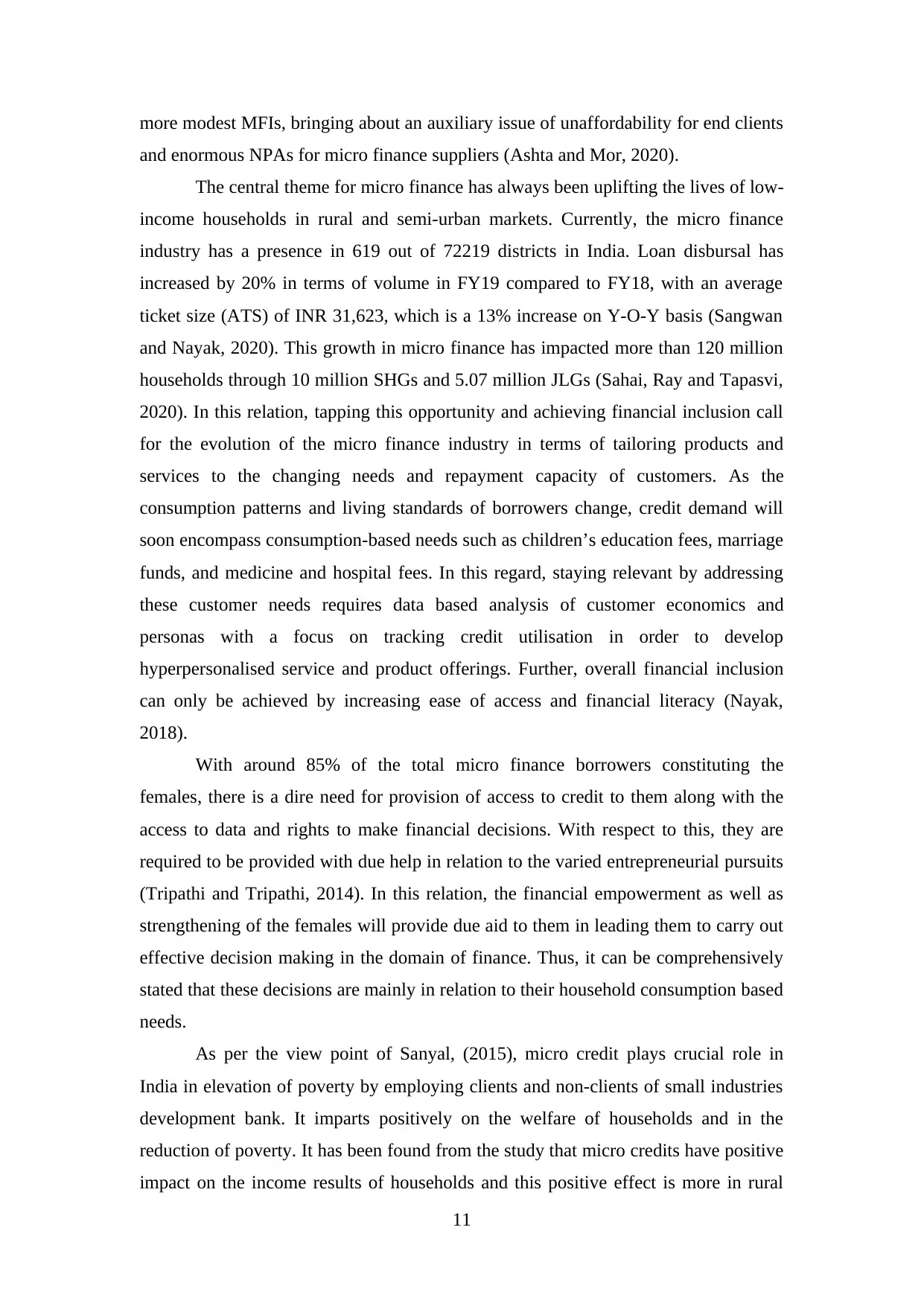
more modest MFIs, bringing about an auxiliary issue of unaffordability for end clients
and enormous NPAs for micro finance suppliers (Ashta and Mor, 2020).
The central theme for micro finance has always been uplifting the lives of low-
income households in rural and semi-urban markets. Currently, the micro finance
industry has a presence in 619 out of 72219 districts in India. Loan disbursal has
increased by 20% in terms of volume in FY19 compared to FY18, with an average
ticket size (ATS) of INR 31,623, which is a 13% increase on Y-O-Y basis (Sangwan
and Nayak, 2020). This growth in micro finance has impacted more than 120 million
households through 10 million SHGs and 5.07 million JLGs (Sahai, Ray and Tapasvi,
2020). In this relation, tapping this opportunity and achieving financial inclusion call
for the evolution of the micro finance industry in terms of tailoring products and
services to the changing needs and repayment capacity of customers. As the
consumption patterns and living standards of borrowers change, credit demand will
soon encompass consumption-based needs such as children’s education fees, marriage
funds, and medicine and hospital fees. In this regard, staying relevant by addressing
these customer needs requires data based analysis of customer economics and
personas with a focus on tracking credit utilisation in order to develop
hyperpersonalised service and product offerings. Further, overall financial inclusion
can only be achieved by increasing ease of access and financial literacy (Nayak,
2018).
With around 85% of the total micro finance borrowers constituting the
females, there is a dire need for provision of access to credit to them along with the
access to data and rights to make financial decisions. With respect to this, they are
required to be provided with due help in relation to the varied entrepreneurial pursuits
(Tripathi and Tripathi, 2014). In this relation, the financial empowerment as well as
strengthening of the females will provide due aid to them in leading them to carry out
effective decision making in the domain of finance. Thus, it can be comprehensively
stated that these decisions are mainly in relation to their household consumption based
needs.
As per the view point of Sanyal, (2015), micro credit plays crucial role in
India in elevation of poverty by employing clients and non-clients of small industries
development bank. It imparts positively on the welfare of households and in the
reduction of poverty. It has been found from the study that micro credits have positive
impact on the income results of households and this positive effect is more in rural
11
and enormous NPAs for micro finance suppliers (Ashta and Mor, 2020).
The central theme for micro finance has always been uplifting the lives of low-
income households in rural and semi-urban markets. Currently, the micro finance
industry has a presence in 619 out of 72219 districts in India. Loan disbursal has
increased by 20% in terms of volume in FY19 compared to FY18, with an average
ticket size (ATS) of INR 31,623, which is a 13% increase on Y-O-Y basis (Sangwan
and Nayak, 2020). This growth in micro finance has impacted more than 120 million
households through 10 million SHGs and 5.07 million JLGs (Sahai, Ray and Tapasvi,
2020). In this relation, tapping this opportunity and achieving financial inclusion call
for the evolution of the micro finance industry in terms of tailoring products and
services to the changing needs and repayment capacity of customers. As the
consumption patterns and living standards of borrowers change, credit demand will
soon encompass consumption-based needs such as children’s education fees, marriage
funds, and medicine and hospital fees. In this regard, staying relevant by addressing
these customer needs requires data based analysis of customer economics and
personas with a focus on tracking credit utilisation in order to develop
hyperpersonalised service and product offerings. Further, overall financial inclusion
can only be achieved by increasing ease of access and financial literacy (Nayak,
2018).
With around 85% of the total micro finance borrowers constituting the
females, there is a dire need for provision of access to credit to them along with the
access to data and rights to make financial decisions. With respect to this, they are
required to be provided with due help in relation to the varied entrepreneurial pursuits
(Tripathi and Tripathi, 2014). In this relation, the financial empowerment as well as
strengthening of the females will provide due aid to them in leading them to carry out
effective decision making in the domain of finance. Thus, it can be comprehensively
stated that these decisions are mainly in relation to their household consumption based
needs.
As per the view point of Sanyal, (2015), micro credit plays crucial role in
India in elevation of poverty by employing clients and non-clients of small industries
development bank. It imparts positively on the welfare of households and in the
reduction of poverty. It has been found from the study that micro credits have positive
impact on the income results of households and this positive effect is more in rural
11
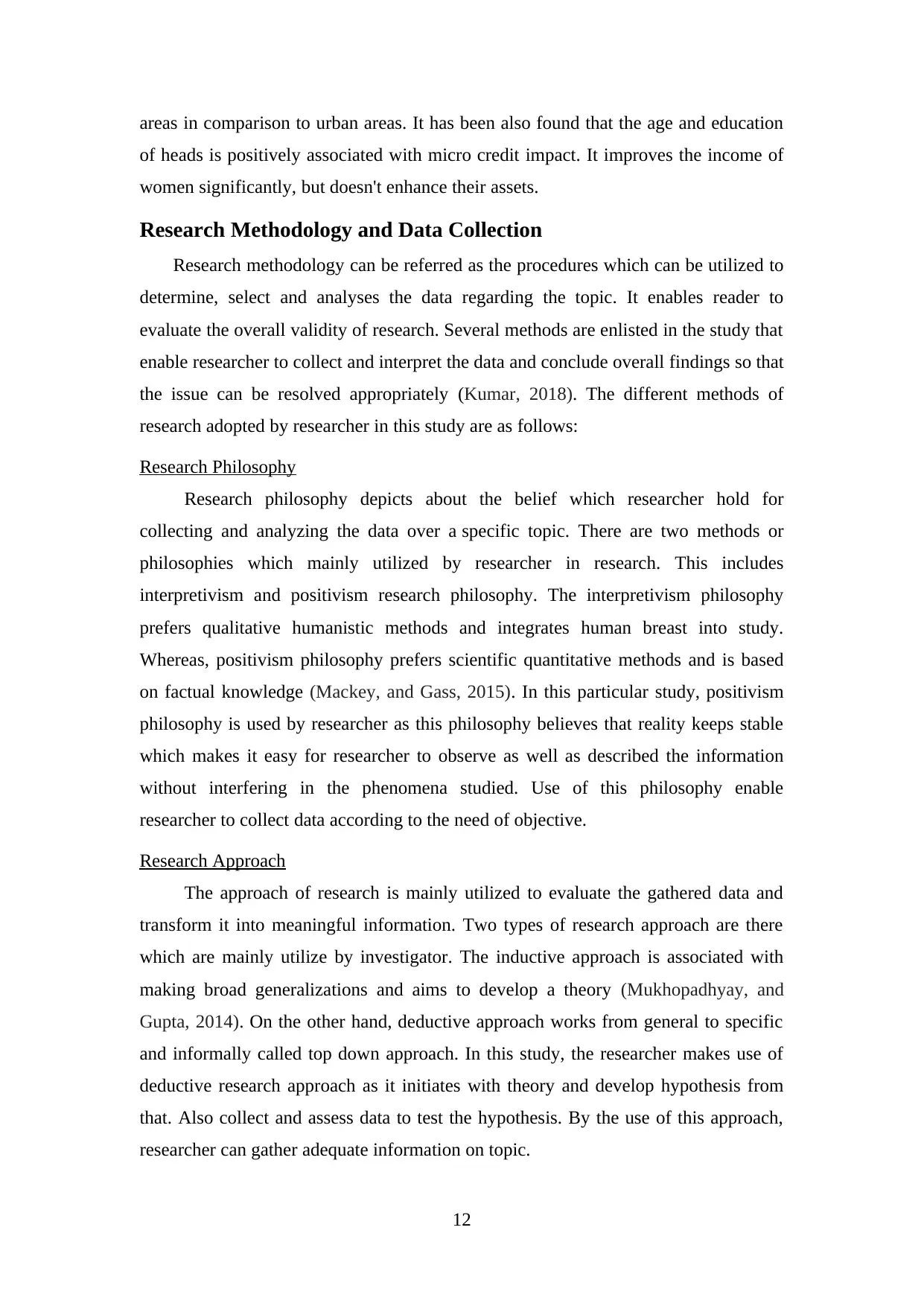
areas in comparison to urban areas. It has been also found that the age and education
of heads is positively associated with micro credit impact. It improves the income of
women significantly, but doesn't enhance their assets.
Research Methodology and Data Collection
Research methodology can be referred as the procedures which can be utilized to
determine, select and analyses the data regarding the topic. It enables reader to
evaluate the overall validity of research. Several methods are enlisted in the study that
enable researcher to collect and interpret the data and conclude overall findings so that
the issue can be resolved appropriately (Kumar, 2018). The different methods of
research adopted by researcher in this study are as follows:
Research Philosophy
Research philosophy depicts about the belief which researcher hold for
collecting and analyzing the data over a specific topic. There are two methods or
philosophies which mainly utilized by researcher in research. This includes
interpretivism and positivism research philosophy. The interpretivism philosophy
prefers qualitative humanistic methods and integrates human breast into study.
Whereas, positivism philosophy prefers scientific quantitative methods and is based
on factual knowledge (Mackey, and Gass, 2015). In this particular study, positivism
philosophy is used by researcher as this philosophy believes that reality keeps stable
which makes it easy for researcher to observe as well as described the information
without interfering in the phenomena studied. Use of this philosophy enable
researcher to collect data according to the need of objective.
Research Approach
The approach of research is mainly utilized to evaluate the gathered data and
transform it into meaningful information. Two types of research approach are there
which are mainly utilize by investigator. The inductive approach is associated with
making broad generalizations and aims to develop a theory (Mukhopadhyay, and
Gupta, 2014). On the other hand, deductive approach works from general to specific
and informally called top down approach. In this study, the researcher makes use of
deductive research approach as it initiates with theory and develop hypothesis from
that. Also collect and assess data to test the hypothesis. By the use of this approach,
researcher can gather adequate information on topic.
12
of heads is positively associated with micro credit impact. It improves the income of
women significantly, but doesn't enhance their assets.
Research Methodology and Data Collection
Research methodology can be referred as the procedures which can be utilized to
determine, select and analyses the data regarding the topic. It enables reader to
evaluate the overall validity of research. Several methods are enlisted in the study that
enable researcher to collect and interpret the data and conclude overall findings so that
the issue can be resolved appropriately (Kumar, 2018). The different methods of
research adopted by researcher in this study are as follows:
Research Philosophy
Research philosophy depicts about the belief which researcher hold for
collecting and analyzing the data over a specific topic. There are two methods or
philosophies which mainly utilized by researcher in research. This includes
interpretivism and positivism research philosophy. The interpretivism philosophy
prefers qualitative humanistic methods and integrates human breast into study.
Whereas, positivism philosophy prefers scientific quantitative methods and is based
on factual knowledge (Mackey, and Gass, 2015). In this particular study, positivism
philosophy is used by researcher as this philosophy believes that reality keeps stable
which makes it easy for researcher to observe as well as described the information
without interfering in the phenomena studied. Use of this philosophy enable
researcher to collect data according to the need of objective.
Research Approach
The approach of research is mainly utilized to evaluate the gathered data and
transform it into meaningful information. Two types of research approach are there
which are mainly utilize by investigator. The inductive approach is associated with
making broad generalizations and aims to develop a theory (Mukhopadhyay, and
Gupta, 2014). On the other hand, deductive approach works from general to specific
and informally called top down approach. In this study, the researcher makes use of
deductive research approach as it initiates with theory and develop hypothesis from
that. Also collect and assess data to test the hypothesis. By the use of this approach,
researcher can gather adequate information on topic.
12
⊘ This is a preview!⊘
Do you want full access?
Subscribe today to unlock all pages.

Trusted by 1+ million students worldwide
1 out of 54
Related Documents
Your All-in-One AI-Powered Toolkit for Academic Success.
+13062052269
info@desklib.com
Available 24*7 on WhatsApp / Email
![[object Object]](/_next/static/media/star-bottom.7253800d.svg)
Unlock your academic potential
Copyright © 2020–2025 A2Z Services. All Rights Reserved. Developed and managed by ZUCOL.





